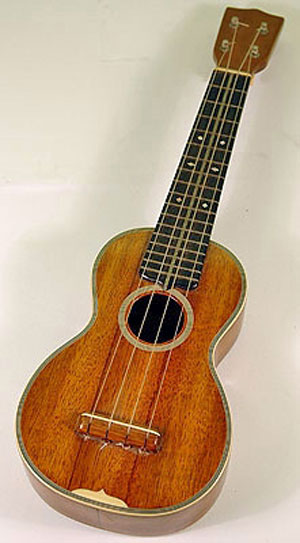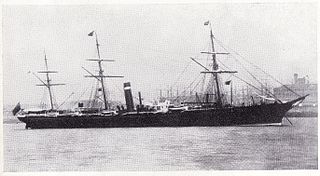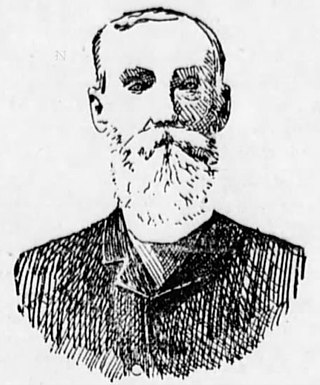
The ukulele, also called a uke, is a member of the lute family of instruments of Portuguese origin and popularized in Hawaii. It generally employs four nylon strings.

Kalākaua, sometimes called The Merrie Monarch, was the last king and penultimate monarch of the Kingdom of Hawaiʻi, reigning from February 12, 1874, until his death in 1891. Succeeding Lunalilo, he was elected to the vacant throne of Hawaiʻi against Queen Emma. Kalākaua had a convivial personality and enjoyed entertaining guests with his singing and ukulele playing. At his coronation and his birthday jubilee, the hula, which had hitherto been banned in public in the kingdom, became a celebration of Hawaiian culture.

Herman Koeckemann, formally Bernard Hermann Koeckemann, SS.CC.,, served as the second vicar apostolic of the Vicariate Apostolic of the Sandwich Islands — now the Roman Catholic Diocese of Honolulu — from 1881 to 1892.

The Japanese in Hawaii are the second largest ethnic group in Hawaii. At their height in 1920, they constituted 43% of Hawaii's population. They now number about 16.7% of the islands' population, according to the 2000 U.S. Census. The U.S. Census categorizes mixed-race individuals separately, so the proportion of people with some Japanese ancestry is likely much larger.

The Treaty of reciprocity between the United States of America and the Hawaiian Kingdom was a free trade agreement signed and ratified in 1875 that is generally known as the Reciprocity Treaty of 1875.

A malasada, sometimes called "Portuguese fried dough," is a Portuguese confection. It is a fried type of doughnut, made of flattened rounds of yeast dough, flavoured with lemon zest and coated with granulated sugar and cinnamon. The traditional Portuguese malasadas do not contain holes or any type of filling, but some variations do, especially the ones made in Hawaii. Some cream fillings include coconut, passion fruit, guava, pineapple and custard. Malasadas are often eaten on Mardi Gras - the day before Ash Wednesday. Its origin can be traced back to the German Berliners. In Portugal, Berliners are slightly bigger than their German counterparts. They are also known as bolas de Berlim, and the filling is frequently an egg-yolk-based yellow cream called creme pasteleiro. The filling is inserted after a half-length cut and is always visible. Regular sugar is used to sprinkle it. They can be found in almost every pastry shop in the country.

Sugarcane was introduced to Hawaiʻi by its first inhabitants in approximately 600 AD and was observed by Captain Cook upon arrival in the islands in 1778. Sugar quickly turned into a big business and generated rapid population growth in the islands with 337,000 people immigrating over the span of a century. The sugar grown and processed in Hawaiʻi was shipped primarily to the United States and, in smaller quantities, globally. Sugarcane and pineapple plantations were the largest employers in Hawaiʻi. Today the sugarcane plantations are gone, production having moved to other countries.
Hawaii has been a notable destination for Korean immigration to the United States since the early 20th century.

Ravenscrag is the name of several ships, some being sailing vessels and some steamships. One of the sailing vessels is historically significant for bringing to the Hawaiian Islands in 1879 Portuguese immigrants who subsequently introduced the ukulele to island culture.

City of Paris was a British passenger liner operated by the Inman Line that established that a ship driven by a screw could match the speed of the paddlers on the Atlantic crossing. Built by Tod and Macgregor, she served the Inman Line until 1884 when she was converted to a cargo ship.
The Africans in Hawaii, also known as Pōpolo in the Native Hawaiian language, are a minority of 4.0% of the population including those partially Black, and 2.3% are of African American, Afro-Caribbean, or African descent alone. The Black population is mostly concentrated in the Greater Honolulu area, especially near military installations. There is also a sizeable Cape Verdean American population, and there are some Hispanic people of African descent, namely Puerto Ricans.

SS Aorangi was a passenger and refrigerated cargo ship built by John Elder & Co. of Govan, Glasgow for the New Zealand Shipping Company and launched in 1883. She was chartered by the Royal Australian Navy (RAN) between April 1914 until 1915. In 1915, she was sunk as a blockship at Scapa Flow. In 1920, she was raised but re-sank in Kirk Bay.

The Priscilla is a wooden bark that is historically significant for being the first of several ships to bring Portuguese immigrants to the Hawaiian Islands, the Priscilla arriving on 30 September 1878 to Honolulu harbor with 120 settlers recruited from the Madeira Islands of Portugal.

The SV Suffolk is a British sailing ship, built in 1857 as a Blackwall Frigate, that in 1881 became the second ship to deliver Portuguese immigrants from the Azores Islands to Hawaii. It was the fourth ship overall to participate in the Portuguese immigration to Hawaii, having been preceded by the SS Priscilla, SS Ravenscrag and SV Highflyer.

The Earl Dalhousie is a full-rigged sailing ship, built in 1862, that transported British settlers in the 1870s to Australia. It was the fifth ship to participate in the Portuguese immigration to Hawaii when it brought contract laborers in 1882 from the Azores Islands to work on the Hawaiian sugarcane plantations.

Spanish immigration to Hawaii began in 1907 when the Hawaiian government and the Hawaiian Sugar Planters' Association (HSPA) decided to supplement their ongoing importation of Portuguese workers to Hawaii with workers recruited from Spain. Importation of Spanish laborers, along with their families, continued until 1913, at which time more than 9,000 Spanish immigrants had been brought in, most recruited to work primarily on the Hawaiian sugarcane plantations.

The Highflyer is a British sailing ship, built in 1861 as a Blackwall Frigate, that in 1880 became the first ship to deliver Portuguese immigrants from the Azores Islands to Hawaii. It was preceded by two ships that brought immigrants from the Madeira Islands, making it the third ship to participate in the Portuguese immigration to Hawaii.

Colonel Edward William Purvis was a British army officer and settler of the Kingdom of Hawaii who served as Vice-Chamberlain during the reign of King Kalākaua. After resigning from the royal household, Purvis published two political satires aimed at undermining the image of the king and his prime minister, Walter M. Gibson, who had been responsible for the removal of Purvis' superior. These actions and other factors led to the demise of the Gibson regime and the Bayonet Constitution of 1887. Purvis died in the following year, after going to the United States to seek medical attention for his health. According to popular legend, he was an expert player of the Portuguese machete or cavaquinho and was believed to be the inspiration for the name of the Hawaiian ukulele.

The 1881 world tour of King Kalākaua of the Hawaiian Kingdom was his attempt to save the Hawaiian culture and population from extinction by importing a labor force from Asia-Pacific nations. His efforts brought the small island nation to the attention of world leaders, but sparked rumors that the kingdom was for sale. Critics in Hawaii believed the labor negotiations were just an excuse to see the world. The 281-day trip gave Kalākaua the distinction of being the first monarch to circumnavigate the globe; his 1874 travels had made him the first reigning monarch to visit the United States and the first honoree of a state dinner at the White House.

John Henry Paty was the Consul to the Netherlands for the Kingdom of Hawaii. He was a businessman who served as an auditor or as a trustee of numerous organizations, and was a founding member of both the Planters’ Labor & Supply Company and the Oahu Railway and Land Company.


























